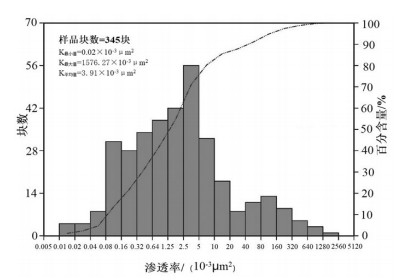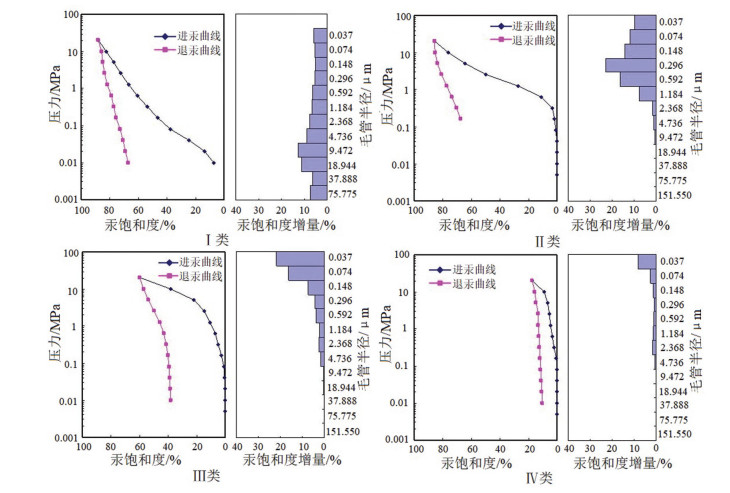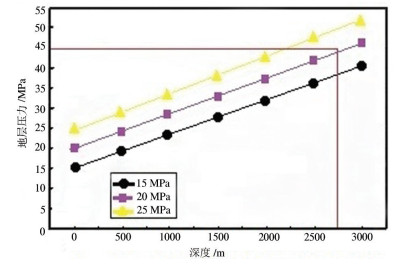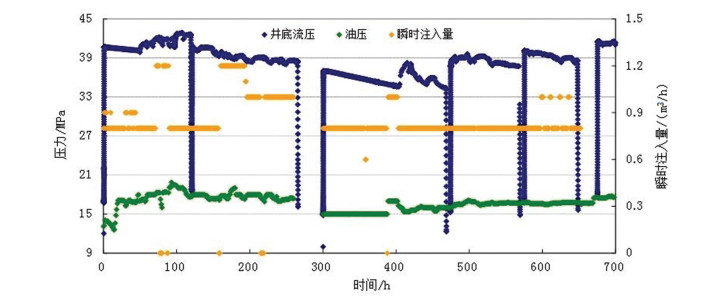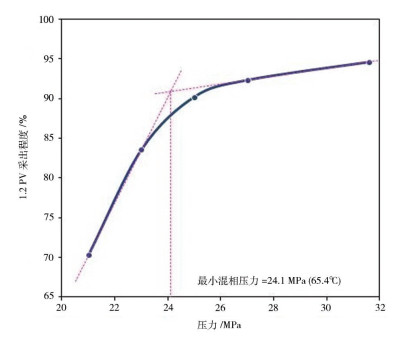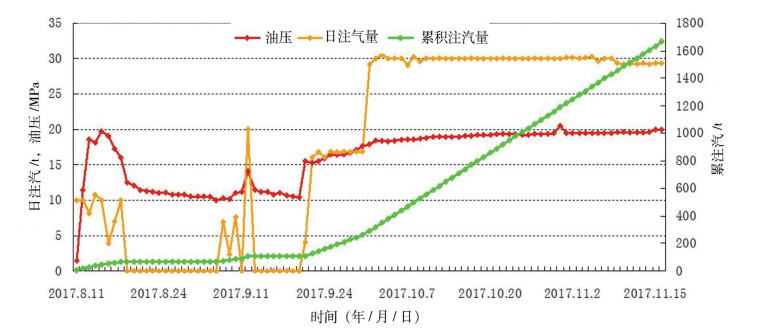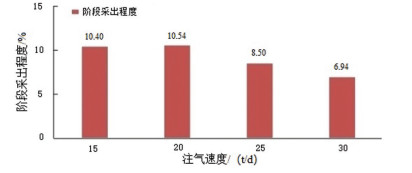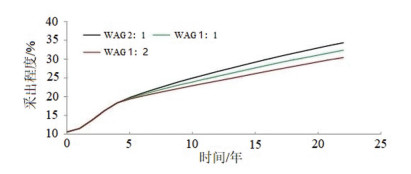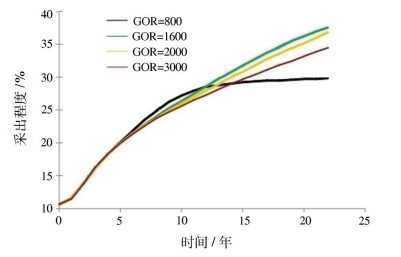Optimum selection of injection-production method for carbon dioxide miscible flooding in low permeability reservoirs: Taking the low-permeability reservoirs of the Kexia Formation in the X zone of the Karamay Oilfield as an example
-
摘要:
研究目的 克拉玛依油田X区克下组低渗透油藏存在物性差、水驱开发采收率低等问题,影响了油田的可持续发展。CO2是全球变暖的主要成分,世界各国都在想方设法减少CO2的排放量,本文试图利用CO2驱油气方式提高该油藏的采收率,变害为利。
研究方法 文章选取研究区60余口取心井目标层位岩心样品,开展扫描电镜及压汞测试分析等研究,系统梳理储层孔隙结构特征。采用油藏数值模拟方法对CO2连续气驱与CO2水气交替驱参数进行了优选,对比了各种开发方式的驱油效果。
研究结果 最后得到了最优的驱油方案: 采用CO2水气交替驱方法,15口井连续注气4年后全部转水气交替注入,气水比为2∶1;气水比10年后调整为1∶1。数值模拟预测,注气开发15年,预测最终采收率将提高30%。
结论 通过现场试注结果表明,试采效果注气后产油量较水驱阶段有明显提高,试采效果注气后产油量是水驱阶段的1.85倍,有明显提高,对实现老区稳产和油田可持续发展具有十分重要的意义。
Abstract:This paper is the result of oil and gas exploration engineering.
Objective The low-permeability reservoirs of the Kexia Formation in the X zone of the Karamay Oilfield have problems such as poor physical properties and low waterflooding development and recovery, which affect the sustainable development of the oilfield. CO2 is the main component of global warming, every country in the world is trying to reduce its content in the atmosphere. This research attempts to use CO2 to drive oil and gas to increase the oil production rate in this reservoir and turn bane into a boon.
Methods According to the core samples of the Lower Karamay formation from more than 60 coring wells in the test area, combined with the data of SEM and mercury injection test, the reservoir characteristics are systematically studied, and the pore structure characteristics of low-permeability sandstone reservoir are clearly studied. Using reservoir numerical simulation technology, the injection and production parameters of CO2 water-gas alternating flooding (CO2-WAG) and CO2 continuous gas flooding were optimized, and on this basis, the two development modes were compared.
Results The optimum technical scheme is obtained: using CO2 water-gas alternating flooding technology, 15 wells are injected with water-gas alternately after 4 years of continuous gas injection. The gas-water ratio is 2:1, the gas-water ratio is 1:1 after 10 years. The numerical simulation predicts that the final recovery rate is increased by more than 30% after 15 years of gas injection development.
Conclusions Experiments show that the oil production after gas injection is 1.85 times that of water injection. The output is increased. It is of great significance to achieve stable production in the old oilfieldsand sustainable development of the oilfield.
-

-
表 1 研究区储层岩屑矿物成分
Table 1. Mineral composition of reservoir debris in the research area

表 2 研究区不同岩性储层孔渗分析
Table 2. Porosity and permeability statistics of reservoirs with different lithology in the research area

表 3 研究区测井孔隙度与渗透率
Table 3. statistical table of reservoir porosity and permeability interpreted by well logging

表 4 研究区储层孔隙结构分类
Table 4. Classification of reservoir pore structure in the research area

表 5 试验区油藏地层及流体基本参数
Table 5. Basic parameters of reservoir formation and fluid in the study area
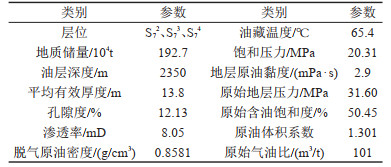
表 6 细管模型基本参数
Table 6. Basic parameters of slim tube

表 7 注CO2细管驱替结果
Table 7. Experiments of CO2 injection in slim pipe displacement

表 8 不同方案设计参数对比及优势分析
Table 8. Comparison of design parameters and analysis of advantages of different schemes

表 9 CO2试注参数
Table 9. CO2 trial note parameter table

表 10 A和B井组试注前后生产情况对比
Table 10. Comparison of production before and after injection test of well groups A and B

-
Asghari K, Al-Dliwe A. 2005. Optimization of carbon dioxide sequestration and improved oil recovery in oil reservoirs[J]. Greenhouse Gas Control Technologies, 7: 381-389.
Bai Yubin, Luo Jinglan, Wang Shaofei, Yang Yong, Tang Leping, Fu Xiaoyan, Zheng Hui. 2013. The distribution of Chang-8 tight sandstone oil reservoir of Yanchang Formation in Wubao area, central-south of Ordos Basin[J]. Geology in China, 40(4): 1159-1168 (in Chinese with English abstract).
Cao Baoge, Han Yonglin, Yu Yongjin, Xiao Ling. 2019. Study on reservoir characteristics change in waterflooding development in Yan 9 reservoir of Nan2 district of Maling oilfield[J]. Xinjiang Geology, 37(3): 373-377 (in Chinese with English abstract).
Chen Hao, Zhang Xiansong, Tang He, Yang Guang, Wang Quan. 2017. Study on the realization conditions of impure CO2 near-miscible flooding in low permeability reservoir[J]. Oilfield Chemistry, 34(4): 631-634 (in Chinese with English abstract).
Cheng Jiecheng, Jiang Hongfu, Lei Youzhong, Pang Zhiqing, Wang Yanyong, An Ping. 2016. Study on miscible CO2 flooding test in strong water-sensitive reservoirs in Sudert oilfield[J]. Xinjiang Petroleum Geology, 37(6): 694-696 (in Chinese with English abstract).
Gharbi R B C. 2004. Use of reservoir simulation for optimizing recovery performance[J]. Journal of Petroleum Science and Engineering, 42(2/4): 183-194.
Guo Maolei, Huang Chunxia, Dong Xiaogang, Zhou Ye, Tang Ruijia. 2018. CO2 EOR mechanism of tight sandstone reservoir in Yanchang oilfield[J]. Chemical Engineering of Oil and Gas, 47(2): 75-79, 88 (in Chinese with English abstract).
He Jialin, Shi Qingsan. Dong Haihai. Hou Rui. 2018. Evaluation of CO2 geological sequestration potential in each block of Xinjiang Jundong oilfield[J]. Journal of Xinjiang University (Edition of Natural Science), 35(4): 528-531 (in Chinese with English abstract).
Jiang Youwei, Zhang Yitang, Liu Shangqi, Guan Wenlong, Chen Yaping, Liu Shuangmou. 2010. Displacement mechanisms of air injection in low permeability reservoirs[J]. Petroleum Exploration and Development, 37(4): 471-476. doi: 10.1016/S1876-3804(10)60048-1
Kovscek A R, Cakici M D. 2005. Geologic storage of carbon dioxide and enhanced oil recovery. II. Cooptimization of storage and recovery[J]. Energy Conversion and Management, 46(11/12): 1941-1956.
Kovscek A R, Wang Y 2005. Geologic storage of carbon dioxide and enhanced oil recovery. I. Uncertainty quantification employing a streamline based proxy for reservoir flow simulation[J]. Energy Conversion and Management, 46(11/12): 1920-1940.
Lai Jin, Han nengrun, Jia Yunwu, Ji Yushan, Wang Guiwen, Pang Xiaojiao, He Zhibo, Wang Song. 2018. Detailed description of the sedimentary reservoir of a braided delta based on well logs[J]. Geology in China, 45(2): 304-318 (in Chinese with English abstract).
Li Jian, Duan Jingjie, Yao Zhenjie, Li Na, Chen Fangping, Zhao Yongpan, Zhao Yang. 2017. Analysis on influence factors of enhanced oil recovery in CO2 flooding after water flooding in low permeability reservoir[J]. Unconventional Oil and Gas, 4(6): 45-52 (in Chinese with English abstract).
Li Yichao, Yao Xianrong, Wang Changquan, Dai Chenyu, Yang Linlin. 2017. Feasibility experimental research on miscible flooding of X reservoir by gas injection[J]. Chemical Engineering of Oil and Gas, 46(4): 63-66 (in Chinese with English abstract).
Ma Yunfei, Zhao Fenglan, Hou Jirui, Duan Xianggang, Li Shi. 2015. Physical simulation of enhancing oil recovery by simultaneous water and gas injection flooding[J]. Petroleum Geology and Recovery Efficiency, 22(5): 89-93, 98 (in Chinese with English abstract).
Meng Fankun, Su Yuliang, Hao Yongmao, Li Yajun, Tong Gang. 2018. Injectivity of CO2 WAG in low permeability oil reservoirs based on B-L equations[J]. Journal of China University of Petroleum (Edition of Natural Science), 42(4): 91-99 (in Chinese with English abstract).
Oldenburg C M, Pruess K, Benson S M. 2001. Process modeling of CO2 injection into natural gas reservoirs for carbon sequestration and enhanced gas recovery[J]. Energy and Fuels, 15(2): 293-298. doi: 10.1021/ef000247h
Shiraki R, Dunn T L. 2000. Experimental study on water-rock interactions during CO2 flooding in the Tensleep Formation Wyoming USA[J]. Applied Geochemistry, 15(3): 265-279. doi: 10.1016/S0883-2927(99)00048-7
Song Jinbo, Tian Tao, Gao Pei. 2016. Reservoir modeling of Chang 6 in Shijia oil block, Qingpingchuan oilfield, Ordos Basin[J]. Geology of Shaanxi, 34(1): 19-24 (in Chinese with English abstract).
Sun Lili, Li Zhiping, Dou Hongen, Hao Xining, Zhang Yunjun, Jiang Kai. 2018. Experiment investigation of the parameters optimization of CO2 flooding in ultra-low permeability reservoir[J]. Science Technology and Engineering, 18(12): 66-70 (in Chinese with English abstract).
Tang Ping, Shi Kuo, Ke Wenqi. 2017. A calculation method and application of temperature and pressure distribution in CO2 injection wells[J]. International Journal of Fluid Dynamics, 5(1): 29-37 (in Chinese with English abstract). doi: 10.12677/IJFD.2017.51004
Wang Chengjun, Hong Ling, Gao Ruimin, Wang Wei, Zhang Zhonglin, Duan Jingjie, Miao Xiaolong. 2018. Staus-quo and challenges of enhanced oil recovery in low permeability reservoirs[J]. Unconventional Oil and Gas, 5(3): 102-108 (in Chinese with English abstract).
Wang Fang, Qin Jishun, Zhou Tiyao, Yang Yongzhi. 2019. CCUS source-sink matching method based on the potential of CO2 flooding[J]. Environmental Engineering, 37(2): 51-56 (in Chinese with English abstract).
Wang Haimei. 2018. Adaptive analysis of CO2 flooding technology and its application in different types of reservoirs[J]. Petroleum Geology and Engineering, 32(5): 63-65 (in Chinese with English abstract).
Wang Shuai, Wang Taichao, Gan Yunyan, Li Hao, Xia Yang. 2019. Summary of prediction methods for minimum miscible pressure of CO2 flooding[J]. Petrochemical Industry Technology, 26(11): 52, 178 (in Chinese with English abstract). http://en.cnki.com.cn/Article_en/CJFDTotal-SHJS201911027.htm
Xi Zhaodong, Tian Zhongbin, Tang Shuheng. 2016. Characteristics and main controlling factors of shale gas reservoirs in transitional facies on the eastern margin of Ordos Basin[J]. Geology in China, 43(6): 2059-2069 (in Chinese with English abstract).
Xiao Xiaoguang, Li Qun. 2014. The reservoir characteristics of Chang 8 oil-bearing formation in the Zhiluo oil field of Ordos Basin[J]. Geology in China, 41(1): 187-196 (in Chinese with English abstract).
Xu Zhengen, Xin Wenming, Liu Yu, Rong Xiaodan, Guan Lu, Wang Xiaoyu. 2019. Production performance and reservoir damage characteristics of CO2 water-alternating-gas injection after continuous CO2 injection for high pour-point reservoir [J]. Fault-Block Oil and Gas Field, 26(5): 613-616 (in Chinese with English abstract).
Yang Fu, Chen Gang, Li Shuheng, Lei Panpan, Tian Tao. 2016. Diagenesis and porosity evolution of Chang 8 oil reservoir group in Qingcheng-Heshui area[J]. Northwest Geology, 49(4): 207-218 (in Chinese with English abstract).
Yang Tiejun, Zhang Yingzhi, Yang Zhengming, Chen Ting. 2019. Mechanism of enhanced oil recovery by CO2 flooding in tight sandstone reservoir[J]. Science Technology and Engineering, 19(24): 113-118 (in Chinese with English abstract).
Ye Heng, Liao Xinwei, Huang Hailong, Zhang Fengyuan, Mu Lingyu. 2015. Optimum selection of carbon dioxide flooding technology for Triassic Chang 6 reservoir[J]. Special Oil and Gas Reservoirs, 22(4): 129-132 (in Chinese with English abstract).
Yuan Qingfeng, Zhu Lili, Lu Huimin, Zheng Xianbao. 2019. Development characteristics and main tackled EOR research direction for the waterflood oilfield at the late stage[J]. Petroleum Geology and Oilfield Development in Daqing, 38(5): 34-40 (in Chinese with English abstract).
Zhang Wei, Gao Qian, Liang Leijiang. 2013. Three-dimensional visualization modeling of oil reservoir research based on petrel technology[J]. Northwestern geology, 46(3): 191-196 (in Chinese with English abstract).
Zhao Jiyong, Xiong Weiliang, Fan Wei, Li Shuman. 2019. Selection and application of oil displacement system for EOR in extra-low permeability reservoirs [J]. Xinjiang Petroleum Geology, 40(6): 720-724 (in Chinese with English abstract).
Zhao Yuechao, Song Yongchen, Liu Yu, Liang Haifeng, Dou Binlin. 2011. Visualization and measurement of CO2 flooding in porous media using MRI[J]. Industrial and Engineering Chemistry Research, 50(8): 4707-4715. doi: 10.1021/ie1013019
白玉彬, 罗静兰, 王少飞, 杨勇, 唐乐平, 付晓燕, 郑卉. 2013. 鄂尔多斯盆地吴堡地区延长组长8致密砂岩油藏成藏主控因素[J]. 中国地质, 40(4): 1159-1168. doi: 10.3969/j.issn.1000-3657.2013.04.014 http://geochina.cgs.gov.cn/geochina/ch/reader/view_abstract.aspx?file_no=20130414&flag=1
曹宝格, 韩永林, 余永进, 肖玲. 2019. 马岭油田南二区延9油藏注水开发储集层特征变化研究[J]. 新疆地质, 37(3): 373-377. doi: 10.3969/j.issn.1000-8845.2019.03.016
陈浩, 张贤松, 唐赫, 杨光, 王全. 2017. 低渗油藏非纯CO2近混相驱及实现条件研究[J]. 油田化学, 34(4): 631-634. https://www.cnki.com.cn/Article/CJFDTOTAL-YJHX201704013.htm
程杰成, 姜洪福, 雷友忠, 庞志庆, 汪艳勇, 安平. 2016. 苏德尔特油田强水敏储集层CO2混相驱研究[J]. 新疆石油地质, 37(6): 694-696. https://www.cnki.com.cn/Article/CJFDTOTAL-XJSD201606012.htm
郭茂雷, 黄春霞, 董小刚, 周晔, 汤瑞佳. 2018. 延长油田致密砂岩油藏CO2驱油机理研究[J]. 石油与天然气化工, 47(2): 75-79, 88. doi: 10.3969/j.issn.1007-3426.2018.02.014
何佳林, 师庆三, 董海海, 侯锐. 2018. 新疆准东油田各区块CO2地质封存潜力评估[J]. 新疆大学学报(自然科学版), 35(4): 528-531. https://www.cnki.com.cn/Article/CJFDTOTAL-XJDZ201804021.htm
蒋有伟, 张义堂, 刘尚奇, 关文龙, 陈亚平, 刘双卯. 2010. 低渗透油藏注空气开发驱油机理[J]. 石油勘探与开发, 37(4): 471-476. https://www.cnki.com.cn/Article/CJFDTOTAL-SKYK201004013.htm
赖锦, 韩能润, 贾云武, 季玉山, 王贵文, 庞小娇, 贺智博, 王松. 2018. 基于测井资料的辫状河三角洲沉积储层精细描述[J]. 中国地质, 45(2): 304-318. http://geochina.cgs.gov.cn/geochina/ch/reader/view_abstract.aspx?file_no=20180207&flag=1
李剑, 段景杰, 姚振杰, 李娜, 陈芳萍, 赵永攀, 赵洋. 2017. 低渗透油藏水驱后注CO2驱提高采收率影响因素分析[J]. 非常规油气, 4(6): 45-52. doi: 10.3969/j.issn.2095-8471.2017.06.008
李轶超, 姚先荣, 王长权, 代宸宇, 杨琳琳. 2017. Ⅹ油藏注气混相驱可行性研究研究[J]. 石油与天然气化工, 46(4): 63-66. doi: 10.3969/j.issn.1007-3426.2017.04.012
罗二辉, 胡永乐, 李保柱, 朱卫平. 2013. 中国油气田注CO2提高采收率实践[J]. 特种油气藏, 20(2): 1-7, 42. doi: 10.3969/j.issn.1006-6535.2013.02.001
马云飞, 赵凤兰, 侯吉瑞, 端祥刚, 李实. 2015. 气水同注驱油技术提高采收率物理模拟[J]. 油气地质与采收率, 22(5): 89-93, 98. doi: 10.3969/j.issn.1009-9603.2015.05.016
孟凡坤, 苏玉亮, 郝永卯, 李亚军, 童刚. 2018. 基于B-L方程的低渗透油藏CO2水气交替注入能力[J]. 中国石油大学学报(自然科学版), 42(4): 91-99. doi: 10.3969/j.issn.1673-5005.2018.04.011
宋进博, 田涛, 高沛. 2016. 鄂尔多斯盆地青平川油田十甲区块长6储层建模[J]. 陕西地质, 34(1): 19-24. doi: 10.3969/j.issn.1001-6996.2016.01.004
孙丽丽, 李治平, 窦宏恩, 郝希宁, 张运军, 姜凯. 2018. 超低渗透油藏CO2驱注入参数优化的研究研究[J]. 科学技术与工程, 18(12): 66-70. doi: 10.3969/j.issn.1671-1815.2018.12.010
唐萍, 石阔, 柯文奇. 2017. 注CO2井井筒温度压力分布计算方法及应用[J]. 流体动力学, 5(1): 29-37.
汪芳, 秦积舜, 周体尧, 杨永智. 2019. 基于油藏CO2驱油潜力的CCUS源汇匹配方法[J]. 环境工程, 37(2): 51-56. https://www.cnki.com.cn/Article/CJFDTOTAL-HJGC201902014.htm
王成俊, 洪玲, 高瑞民, 王伟, 张忠林, 段景杰, 苗小龙. 2018. 低渗透油藏提高采收率技术现状与挑战[J]. 非常规油气, 5(3): 102-108. doi: 10.3969/j.issn.2095-8471.2018.03.018
王海妹. 2018. CO2驱油技术适应性分析及在不同类型油藏的应用——以华东油气分公司为例[J]. 石油地质与工程, 32(5): 63-65. doi: 10.3969/j.issn.1673-8217.2018.05.016
王帅, 王泰超, 甘云雁, 李昊, 夏阳. 2019. CO2驱最小混相压力预测方法综述[J]. 石化技术, 26(11): 52, 178. doi: 10.3969/j.issn.1006-0235.2019.11.027
郗兆栋, 田忠斌, 唐书恒. 2016. 鄂尔多斯盆地东缘海陆过渡相页岩气储层孔隙特征及影响因素[J]. 中国地质, 43(6): 2059-2069. http://geochina.cgs.gov.cn/geochina/ch/reader/view_abstract.aspx?file_no=20160617&flag=1
肖晓光, 李群. 2014. 鄂尔多斯盆地直罗油田长8油层组储层特征研究[J]. 中国地质, 41(1): 187-196. http://geochina.cgs.gov.cn/geochina/ch/reader/view_abstract.aspx?file_no=20140114&flag=1
许正恩, 辛文明, 刘誉, 荣晓丹, 管璐, 王小宇. 2019. 高凝油油藏CO2驱转水气交替驱动态及储层伤害特征[J]. 断块油气田, 26(5): 613-616. https://www.cnki.com.cn/Article/CJFDTOTAL-DKYT201905016.htm
杨甫, 陈刚, 李书恒, 雷盼盼, 田涛. 2016. 庆城合水地区长8油层组储层成岩作用及孔隙演化[J]. 西北地质, 49(4): 207-218. https://www.cnki.com.cn/Article/CJFDTOTAL-XBDI201604024.htm
杨铁军, 张英芝, 杨正明, 陈挺. 2019. 致密砂岩油藏CO2驱油提高采收率机理[J]. 科学技术与工程, 19(24): 113-118. https://www.cnki.com.cn/Article/CJFDTOTAL-KXJS201924021.htm
叶恒, 廖新维, 黄海龙, 张凤远, 穆凌雨. 2015. 三叠系长6油藏二氧化碳驱技术方案优选[J]. 特种油气藏, 22(4): 129-132. https://www.cnki.com.cn/Article/CJFDTOTAL-TZCZ201504034.htm
袁庆峰, 朱丽莉, 陆会民, 郑宪宝. 2019. 水驱油田晚期开发特征及提高采收率主攻方向[J]. 大庆石油地质与开发, 38(5): 34-40. https://www.cnki.com.cn/Article/CJFDTOTAL-DQSK201905005.htm
张伟, 高倩, 梁雷江. 2013. 基于Petrel技术的油藏三维可视化建模研究[J]. 西北地质, 46(3): 191-196. https://www.cnki.com.cn/Article/CJFDTOTAL-XBDI201303021.htm
赵继勇, 熊维亮, 范伟, 李姝蔓. 2019. 特低渗透油藏提高采收率驱油体系筛选及应用[J]. 新疆石油地质, 40(6): 720-724. https://www.cnki.com.cn/Article/CJFDTOTAL-XJSD201906013.htm
郑永旺. 2017. 苏北低渗油藏CO2驱最小混相压力计算方法研究[J]. 石油地质与工程, 31(2): 101-104. https://www.cnki.com.cn/Article/CJFDTOTAL-SYHN201702027.htm
周雪, 张创, 王嘉歌, 井亚洁. 2019. 低渗透储层地质状况分析及提高采收率的方法研究——评《低渗透油田开发技术》[J]. 新疆地质, 37(2): 284. https://www.cnki.com.cn/Article/CJFDTOTAL-XJDI201902028.htm
-



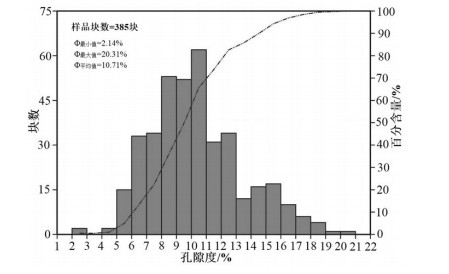
 下载:
下载:
